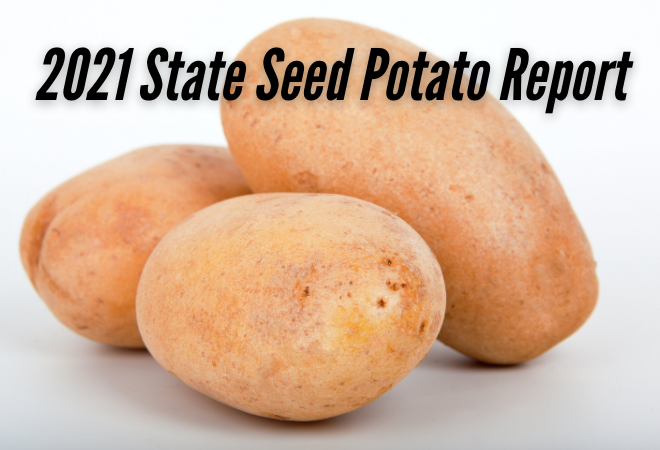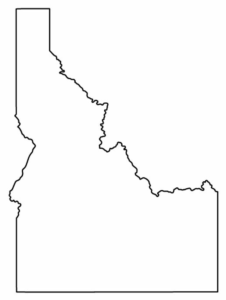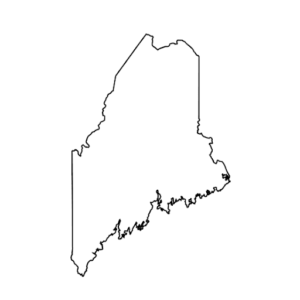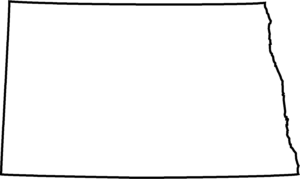
2021 state-by-state seed potato report
The 2021 growing season saw U.S. seed potato farmers plant 106,651 acres that were eventually accepted as certified seed. That is up nearly 2,800 acres from last year.
At just shy of 31,000 acres, Idaho led all states in seed potato production. Conditions were hot and dry during significant parts of the season, which resulted in below-average yields, although totally is “excellent,” reported Alan Westra of the Idaho Crop Improvement Association.
Conditions also were hot in neighboring Montana, which had almost 11,000 acres of certified seed, which ranked third behind Idaho and North Dakota (14,442 acres). An August break in the heat allowed tubers to bulk, and yields were better than originally expected. This year marked the 100th certified seed crop for Montana.
Russet Burbank remains the most-grown seed potato in the U.S. Accepted certified acres of Burbank varieties totaled just under 17,000 acres. Russet Norkotah varieties totaled 11,534 acres.
Here are state-specific reports on seed potato growth from around the country:
Colorado
All field-grown seed potatoes in Colorado are produced in the San Luis Valley, which is a high elevation desert in south central Colorado. Planting went well this spring, however, we were hit with multiple hail events affecting random fields at different times throughout the summer.
Overall, day temperatures were warmer than average with cool night temperatures, making it ideal for potato production. Hail set the crop back, depending on the damage severity and timing of the hail event, which made for difficult visual inspections in some cases.
Certified seed growers began killing vines in late July and continued through early- to mid-August, limiting potential spread of virus by late season aphid flights. As of Oct. 20, all certified seed potato acreage has been harvested in Colorado. Overall, crop yields have hovered around average to slightly below average, depending on potato variety grown and severity of hail damage during the summer months. Certified seed growers have submitted their seed samples for the postharvest test.
Our postharvest test will be taking place on the North Shore of Oahu, Hawaii, again this year. A postharvest test is required on all certified seed in Colorado, whether it is sold commercially or for recertification. An official 2021 certified seed directory is posted online at potatoes.colostate.edu/programs/potato-certification-service/crop-directory/. Additional information can be found at www.coloradocertifiedpotatogrowers.com.
In 2021, Colorado certified seed potato acreage for sale and grower plant-back was down from 8,504 acres in 2020 to 7,784 in 2021. The 2021 accepted certified acreage after summer field inspections was 7,631 acres. Over 120 different potato varieties were entered into Colorado’s certified seed program this year. Rejections were primarily the result of blackleg, with a few rejections caused by PVY/mosaic and variety mix. Total potato acreage (both certified and commercial) in the San Luis Valley was 48,265, down from 50,923 acres in 2020.
The 2021 top five certified potato varieties were:
- Russet Norkotah selections, 1,976 acres
- Canela Russet, 695 acres
- Reveille Russet, 617 acres
- Centennial Russet, 531 acres
- Soraya, 394 acresa
Of note, Reveille Russet has been gaining some popularity in Colorado seed production. A wide range of potato varieties are certified in Colorado, including multiple varieties of russets, reds, yellows, chippers, fingerlings and specialties.
All seed lots imported into Colorado are required to undergo a postharvest test and a PVY-N tolerance of 1.0% is in place for all incoming seed. Also, there is a late blight quarantine in effect for all seed coming into the San Luis Valley. If you are planning on shipping any seed into the valley, this test needs to be conducted by a qualified lab prior to shipment. Check our website for testing specifics at potatoes.colostate.edu/wp-content/uploads/2014/02/Late-Blight-Quar-2014.pdf. — Report by Andrew Houser, Manager, Colorado Potato Certification Service
Idaho
The 2021 season in Idaho began with normal weather and planting was completed without serious interruption. Abnormally hot and hazy conditions prevailed June through mid-August, which exacerbated concerns about potential water shortages. Most growers did have sufficient water to complete their potato crops, in some cases at the expense of rotation crops. The latter half of August and September have been more seasonable.
 Harvest has generally proceeded at a normal pace and neared completion as of mid-October. Yields are reported to be lower — significantly so in some cases — but seed quality going into storage is reported as excellent. The 2021 crop appears to have a very nice size profile.
Harvest has generally proceeded at a normal pace and neared completion as of mid-October. Yields are reported to be lower — significantly so in some cases — but seed quality going into storage is reported as excellent. The 2021 crop appears to have a very nice size profile.
Seed health is also good this year. During summer inspections, the number of seed lots with visually detectable levels of PVY increased slightly over 2020, but remains below the 10-year average of 7.8%. Black leg levels were normal and there were no detections of potato leaf roll or bacterial ring rot again this year.
A complete listing of this year’s seed potato crop is available in the 2021 Idaho Certified Seed Potato Directory. This is posted on the Idaho Crop Improvement at www.idahocrop.com.
At the conclusion of the second round of field inspections, a total of 30,940 acres are eligible for final certification this year. This is an increase of 2.9% from 2020 and, excluding proprietary genetics, includes a total of 133 varieties, selections and advanced clones.
Ten varieties account for more than 80% of the total acres, with Russet Burbank, Russet Norkotah (all strains), Ranger Russet, Clearwater Russet and Alturas continuing as the dominant varieties. — Report by Alan Westra, Southeast Area Manager, Idaho Crop Improvement Association
Maine
The 2021 growing season was much less challenging than what growers experienced in 2020. Seed acreage was up almost 10% from last year, and rain events were more plentiful and much more normal than the prolonged dry periods the past several years. This led to significantly higher yields for growers in most cases.
 Overall, the 2021 crop appears to be healthy with low to moderate disease levels. As of Sept. 9, the certification program has 10,168 acres field certified from 90 farms.
Overall, the 2021 crop appears to be healthy with low to moderate disease levels. As of Sept. 9, the certification program has 10,168 acres field certified from 90 farms.
The top acreage varieties certified for 2021 are:
- Caribou Russet (PVP), 1,259 acres
- Russet Burbank (MT strain), 914 acres
- Atlantic, 808 acres
- Snowden, 686 acres
- Lamoka (PVP), 654 acres
Inspectors are now performing PCN soil sampling and are in preparation for laboratory PVY post-harvest testing. All samples will be ELISA post-harvest tested at the certification laboratory in Presque Isle.
Nancy McBrady is the Director of the Bureau of Agriculture, Food and Rural Resources for the State of Maine Department of Agriculture, Conservation and Forestry. Amanda Beal is the Commissioner of the State of Maine Department of Agriculture Conservation and Forestry. — Report by Eric Hitchcock, Seed Certification Program Manager, Maine Department of Agriculture, Conservation and Forestry
Minnesota
Seed potato growers in Minnesota applied to certify 5,685.75 acres for the 2021 crop year, a decrease from 6,267.41 acres in 2020. There were 52.25 acres rejected for severe mosaic, varietal mix and not meeting eligibility, resulting in 5,633.50 certified acres. Russet Burbank was the variety with the most acres planted.
The spring brought warm weather and dry conditions throughout the state. Most certified seed potato growers were able to get in the field in late April to early May, with most completing planting by early June. Below average rainfall continued into the summer. The Minnesota Department of Agriculture (MDA) inspectors were busy, with three inspections conducted on all certified seed potato lots.
July was warm and dry, affecting the growing conditions, followed by a warm August and September. The heat during this period affected some quality and yields and delayed harvest some days. Overall, growers reported the harvest produced average to below average yields statewide with good quality.
The MDA Potato Inspection Unit uses a generation system and remains vigilant in detecting potato virus and other disease. The Certified Seed Potato Program continues to honor the USDA Animal and Plant Health Inspection Service memorandum of understanding for Necrotic Virus Management Plan. The global pandemic is still affecting farming communities throughout Minnesota. Agriculture Commissioner Thom Petersen continues to provide guidance for each farm implementing a COVID-19 plan, providing safety measures for growers and all who work in the industry.
The Minnesota Department of Agriculture will be conducting the postharvest winter test on the North Shore of Oahu, Hawaii, again this year. Samples were collected in October at the office in East Grand Forks while observing social distancing and COVID-19 guidelines. The samples will be planted, and each lot observed visually for stand, vigor, and potato virus. All positive potato virus visual observations are confirmed with a laboratory test.
Once complete, the results will be communicated to the growers and industry. For copies of the Minnesota Certified Seed Potato Directory please visit the Minnesota Department of Agriculture website at www.mda.state.mn.us. — Report by Eric Byre, Plant Protection Program Supervisor
Montana
This year marks the 100th certified seed potato crop in Montana. The 2021 Montana seed potato harvest was completed in record pace by the second week of October with very good quality, average yields and no frost damage. The growing season was very challenging throughout the West with high temperatures in June and July. Cooler August temperatures allowed for adequate bulking and better yields than originally expected. Disease pressure for PVY and all foliar pathogens was very low during the growing season.
In 2021, 10,930 acres representing 84 varieties were grown in Montana. Russet Burbank is the most widely grown variety in Montana at 3,713 acres and has held steady over the past five years. Umatilla has the second highest acreage at 1,410 which represents a decrease of 21% since 2017. The strongest mover in Montana’s portfolio is Clearwater which is a close third, and has increased 99% from 697 acres in 2017. Ranger Russet was edged out by Clearwater to become the fourth-place variety and has been relatively steady over the past five years at 1,204 acres.
The fifth-most widely grown variety is Alturas at 693 acres. Russet Norkotah TX (278) is the most widely grown Norkotah selection at 581 acres and has held very steady over the past five years. Russet Norkotah TX (296) increased substantially from 76 acres in 2017 to 276 acres in 2021. Russet Norkotah CO (3) is holding steady at 252 acres and Russet Norkotah TX (112) is increasing very rapidly from 7 acres in 2017 to 195 acres in 2021. The other variety on the rise is Ivory Russet, which has expanded from 17 to 252 acres in five years.
Norland Dark Red was the highest acreage red variety at 94 acres. Snowden and Lamoka at 80 and 46 acres, respectively, were the main chip varieties grown in Montana.
Montana will be performing its postharvest test on Oahu, Hawaii, with planting in November and visual inspections and leaf testing late December through mid-January. In addition to the field inspections and leaf testing, Montana growers submit duplicate samples of Generation 1 and Generation 2 seed lots for direct tuber testing using PCR. This delivers early information to the growers on suitability of lots for recertification, as well as a back-up to the field sample in the event of complications in the field. — Report by Nina Zidack, Director, Montana Seed Potato Certification Program
Nebraska
Acres entered for seed certification in Nebraska totaled 6,806,52, with 6,789.20 passing summer field inspections and virus testing. The five most common varieties grown in were:
- Frito Lay varieties, 3,183.01 acres
- Russet Norkotah (and strains), 1,049.88 acres
- Umatilla Russet, 474.29 acres
- Russet Burbank, 235.19 acres
- Atlantic, 215.71 acres
After a series of heavy rainstorms in the spring, summer growing conditions became exceptionally warm. This resulted in lower sets but had a negligible effect on seed quality. Summer field inspections and virus testing indicate an increase in PVY incidence across the state.
A total of 317 lots will be sent to the winter grow-out at Twin Bridge Farm in Waialua, Hawaii. The remaining lots either did not pass summer field inspections/virus testing or will not be recertified. — Report by Adam Winchester, Manager, Potato Certification of Nebraska
New York
In 2021, seed potato acres were down 10% from 2020 with 546 total acres inspected. We had a decent spring season leading to timely planting in most areas of the state. Since the beginning of July, many areas of New York have been above average in rainfall. The rains have led to above average yields, a 10 to 25% increase. Tubers are average size to larger than usual and quality has been good. Harvest was nearly done as of Oct. 20, despite scattered showers throughout September and October.
Lamoka represents the largest acreage entered for certification in New York with Lady Liberty (NY152) and Waneta, the next highest acreages.
We are currently preparing samples for our winter grow out in Waialua, Hawaii in November.
More detailed information about varieties and acres entered for certification can be found in our 2020 Potato Crop Directory available by calling New York Seed Improvement Project at 607-255-9869 or e-mail [email protected]. — Report by Philip Atkins, Manager, New York Seed Improvement
North Dakota
Despite record-setting drought statistics for North Dakota, seed potato growers were still able to harvest a crop. The drought was the worst on record since 1988, and then since the dust bowl years. While record highs for temperature were not broken in given days, the number of consecutive days of higher than average temperatures contributed greatly to the drought intensity.
 This 2021 crop was affected by the dry 2020 fall, followed by a winter with relatively little moisture. Our dryland growers were forced to plant into a moisture deficit soil. And after that, there was limited moisture from scattered localized showers. The consistent high temperatures and smoky overcast from northern and western fires affected yields in both dryland and irrigated potatoes.
This 2021 crop was affected by the dry 2020 fall, followed by a winter with relatively little moisture. Our dryland growers were forced to plant into a moisture deficit soil. And after that, there was limited moisture from scattered localized showers. The consistent high temperatures and smoky overcast from northern and western fires affected yields in both dryland and irrigated potatoes.
While too late to affect yields, rains just prior to and during harvest helped condition the dryland soils for a smoother harvest. Growers still had to deal with dirt clumps. Quality appears to be good, but the size profile is reduced due to the summer heat and moisture stress. Harvested quantity generally is 66% of average on dryland acres, and maybe 90% on irrigated acreage. Processing varieties yielded less than average with a smaller profile. Seed potatoes will be limited this year.
Leaf samples were taken from required seed lots for serological potato virus testing, including PVY and PVX. Laboratory results matched field inspection notes. Inspectors collected random symptomatic blackleg stems and subjected them to lab testing against Dickeya dianthicola. To date, no positives have been confirmed. Several growers will continue Dickeya dianthicola testing on their harvested tubers.
Seed growers were proactive with protective fungicides, reducing potential for Alternaria solani and Phytophthora infestans. Growers monitored the Blight Alert programs for the region. No late blight was reported. Mosaic vectoring aphid counts were tracking below the previous year, slightly decreasing the vector risk factor. Again, seed growers were strongly encouraged to use protective oils and insecticides through the growing season and vine kill as early as possible.
The 2021 crop included 14,443 acres which passed field inspection tolerances for certification, just 103 acres less than 2020.
The top five varieties were: Norland strains, 2,544 acres; Umatilla Russet, 2,143 acres; Bannock Russet, 1,266 acres; Dakota Pearl, 1,117 acres; and Ranger Russet, 1,081 acres. The 2021 seed directory can be accessed at www.nd.gov/seed/.
North Dakota State Seed Department tissue culture and greenhouse staff harvest minituber crops in June and October. These minitubers will supply North Dakota seed growers with the first field year crop of 2022, creating a clean seed source for crops in future years. Nearly all early field generation seed lots in North Dakota are planted in very isolated areas in the western part of the state. Inspection results indicated freedom from viruses.
Threat by aphid populations, mosaic or late blight inoculum was very low and not observed. These seed lots provide the basis for future North Dakota seed production.
The cycle of seed potato certification continues as North Dakota certified seed growers randomly select tubers from 2021 crop seed lots requiring a postharvest test planted in Homestead, Florida. Results from this stage of testing will determine seed lots eligible for certification for the future 2022 crop. — Report by Kent Sather, Director, Potato Programs, North Dakota State Seed Department
Oregon
In 2021, Oregon Seed Certification Service (OSCS) certified 3,052 acres of seed potatoes, about 10% higher than our 10-year average and just shy of 200 acres more than 2020.
Several lots were rejected this year due to seedborne PVY, and others had to be withdrawn due to the lack of irrigation water to finish out the season. We also had some problems with variety mix and chemical injury, but overall most seed lots looked very nice and were relatively free of disease observed during field inspections. Complete field readings can be found at seedcert.oregonstate.edu/crop-information/potatoes.
Planting conditions were near ideal this year, but very hot temperatures, often above 100℉, predominated much of the growing season. The high daytime temperatures did not seem to affect yields appreciably in the seed growing areas (where there was adequate water to irrigate) however it may have had a negative impact on tuber shape and sizing. Harvest conditions have been mild and dry which should mean fewer storage-related issues this winter. In some areas higher levels of heat related tuber rots were observed, as well as some lots with heavy scab.
The No. 1 variety produced in Oregon this year was Clearwater Russet at 338 acres, followed closely by Lamoka and Frito-Lay varieties. Varieties with yellow or red/pink skin, like Ciklamen and Gala, now make up almost 25% of the acres produced. There has been a major shifting through the years regarding the source of Oregon seed lots, shifting away from the Western states, like Montana and Idaho, toward Nebraska (45%), Canada (10%) and several Central states. See our webpage under “Seed Report and Directory of Growers” for a complete listing of varieties produced and sources.
Labor shortages continued to be a problem for both the Oregon growers, as well as for the Oregon Seed Certification Service potato program. We were able to hire two new full-time statewide inspectors — Craig Agidus and Mason McKinney — which will help with potato inspections in the field and/or the winter grow-out greenhouses, however, filling the local harvest inspectors, seed samplers and office positions has been challenging. — Report by Jeff McMorran, Oregon Seed Certification Service
Washington
A total of 3,648 acres of seed potatoes were entered for certification during the 2021 growing season. This is a 121-acre increase from last year.
Top four varieties grown:
- Ciklamen, 582 acres
- 907-15 (private cultivar), 317 acres
- Chieftain, 285 acres
- Russet Burbank, 234 acres
The total acres planted include 146 different potato varieties ranging in size, anywhere from partial-acre plots to 68-acre fields. Most seed lots are less than 20 acres and include numbered clones, table stock, processing and heirloom varieties. This year saw 478 individual seed lots entered for certification from nine separate farms.
This year, Washington’s climate was hot and dry. Drought conditions were noted throughout the state and growers in the northwestern part of the state saw the need for more irrigation, instead of relying on natural rainfall. Washington State Department of Agriculture (WSDA) staff noted that late blight and black leg disease pressure was slight to nonexistent.
Harvest began two weeks earlier than normal at the beginning of September and should be done by late October. Yields are noted to be fair and average, even with prolonged heat conditions. WSDA noted few external damage to the tubers, such as knob growth, which can be graded out at time of harvest and shipping. Seed shipments to southern climates will begin in late fall and will continue into the winter months, with the majority of seed to be shipped in early spring.
Washington State Certified seed growers are in the process of submitting seed lot samples for the postharvest test to be conducted in Hawaii. — Report by Benita Matheson, Plant Services Supervisor, Washington Department of Agriculture
Wisconsin
Wisconsin’s seed potato production is up 2% in 2021, a total of 9,499.56 acres passing summer inspections.
Varieties remain strongly oriented toward chips, with Atlantic, Lamoka and proprietary varieties leading the list of top varieties. Manistee, Mackinaw are of increasing interest in the chip market. Silverton russet remains a strong fresh-market russet, however several upcoming varieties Reveille, Caribou, Plover and Lakeview russets are getting more established.
Planting operations this season began early for some seed operations and progressed relatively quickly through the moderate Spring weather, conditions turned hot late in planting and near emergence. The climate in Wisconsin moderated following late spring heat, allowing for a good growing season without extremes in temperature. Early season blackleg was low, despite the heat.
Rainfall was regular through-out the growing season, with only average irrigation amounts to meet crop needs. Vine-killing began earlier this growing season with early bulking on some varieties.
Harvest conditions, despite some hot and humid days, were optimal, allowing much of the seed area an excellent period of digging days. Yields for many growers were reportedly up with some storages at or beyond capacity.
The Wisconsin postharvest test will continue to occur in South Florida. — Report by Alex Crockford, Program Director, Wisconsin State Certification Program
EDITOR’S NOTE: A seed report for Michigan was not available at press time.







